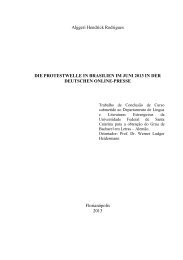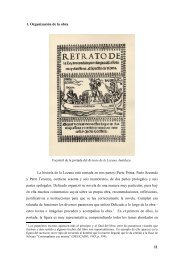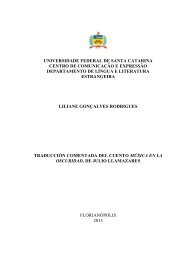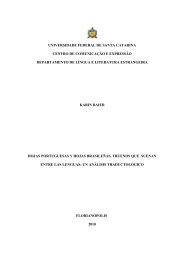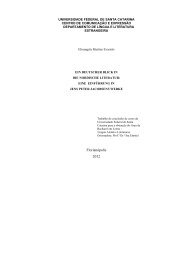TCC - Marcia Regina Barreto Moraes - Departamento de Língua e ...
TCC - Marcia Regina Barreto Moraes - Departamento de Língua e ...
TCC - Marcia Regina Barreto Moraes - Departamento de Língua e ...
You also want an ePaper? Increase the reach of your titles
YUMPU automatically turns print PDFs into web optimized ePapers that Google loves.
“The tale of Odysseus´ journey home is a common theme of this tradition, called the nostos - -<br />
homecoming. The epic form of this tale as we know it is most likely the synthesis of several oral<br />
traditions. The twenty four books of dactylic hexameter we now know as the Odyssey have been<br />
transmitted with various textual variation since about 300 B.C.E.” (bookrags.com)<br />
"The Odyssey is Homer's story of the return of Odysseus from the Trojan War to his palace on the island<br />
of Ithaca and his battle to regain the kingship there after a long absence.” (odysseus-unbound.org)<br />
3 “The proper METHOD for studying poetry and good letters is the method of contemporary<br />
biologists, that is the careful first-hand examination of the matter, and continual COMPARISON<br />
of one ‘sli<strong>de</strong>’ or specimen with another.” (Pound)<br />
“O MÉTODO a<strong>de</strong>quado para o estudo da poesia e da literatura é o método dos biologistas<br />
contemporâneos, a saber, exame cuidadoso e direto da matéria e contínua COMPARAÇÃO<br />
<strong>de</strong> uma “lâmina” ou espécime com outra.”(Pound)<br />
4 “The narrator is always in a specific temporal position relative to the story he/she is telling. Genette<br />
<strong>de</strong>scribes four kinds of narration:<br />
1. Subsequent narration: This is the most common temporal position. The narrator tells what happened in<br />
some past time.<br />
2. Prior narration: The narrator tells what is going to happen at some future time. This kind of narration<br />
often takes the form of a dream or prophecy.<br />
3. Simultaneous narration: The narrator tells his/her story at the very moment it occurs.<br />
4. Interpolated narration: This complex type of narration combines prior and simultaneous narration. For<br />
example, a narrator tells what he experienced during the day (after the fact), and also inclu<strong>de</strong>s his current<br />
impressions about these events”. (Guillemette and Lévesque)<br />
5 “No discurso narrativo, o ponto <strong>de</strong> vista indica os modos <strong>de</strong> presença do narrador. Evitando a<br />
polissemia da noção e utilizando o termo focalização nesse contexto, G. Genette propõe<br />
41



